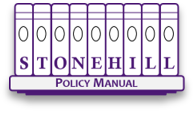Effective Date: November 11, 2019
Last Reviewed: November 11, 2019
Fire safety is an important consideration in office and classroom environments. It is vital that faculty and staff be informed and prepared for fire emergencies. Awareness of potential fire hazards, or factors that prevent exit from an area or building, is key.
Building Evacuation
Department Heads and Faculty Deans (or their designees) should be familiar with the evacuation plans and emergency exit routes established for the buildings they occupy. They should discuss what to do in the event of a fire and periodically review the plans with their departments. Each faculty member should review the fire escape routes posted in the classrooms they utilize. The Chief of Campus Police and the Director of Facilities Management (or their designees) are available to consult with Department Heads and Deans regarding their departments’ fire safety plans. Alternate exit routes should be identified for use if the primary exit is blocked. Employees should become familiar with the location of fire alarm pull stations. When a building fire alarm system is activated, faculty and staff must evacuate immediately and not remain in the building; evacuation time is of utmost importance.
Faculty and staff should fully participate in periodic fire drills of administrative and academic buildings when such drills are planned by the College.
Exit Passageways
Aisles within rooms, main corridors, and stairwells must be kept free and clear of any materials that will block, hinder, or slow evacuation during an emergency. Any blockage can hinder fire and rescue personnel. Do not store materials or equipment in corridors or stairwells. Such storage narrows the exit path and is fuel for the fire.
Exit Doors
Keep stairwell doors, classroom doors, and corridor doors closed at all times. The only exceptions are doors that are held open via automatic hold open devices. These devices are connected to building fire alarm systems and automatically release upon activation of the alarm. Keeping doors closed helps to prevent the spread of fire.
Sprinkler Heads
In buildings with sprinkler systems, do not place or store material within 18 inches of sprinkler heads. When sprinklers are activated, a full spray pattern is needed to effectively control the fire.
Extinguishers and Pull Stations
Never block or store items in front of fire extinguishers, fire alarm pull stations, or fire alarm audio-visual devices. Immediate access is critical in the event of a fire.
Open Flames
Open flames such as candles are not allowed in offices or classrooms. They can easily tip over and/or light combustible items on fire. This requirement does not apply to supervised use of an open flame as part of an academic activity, for example the use of a Bunsen burner during a science class.
Appliances
Microwaves, toaster ovens, crockpots, hot plates, refrigerators, and other appliances are not allowed unless already present in a kitchen space or other areas designated in a building. Nothing herein will be interpreted to limit an employee’s ability to seek accommodations for specific needs through the process established by the Office of Human Resources.
Space Heaters
Portable space heaters are not allowed in office or classrooms without the approval of the Director of Facilities Management or their designee.
Electrical Cords
All electrical cords and plugs must be in good condition. Never use equipment with frayed cords or exposed wires. If discovered, immediately take the equipment out of service and have it repaired or replaced.
Extension Cords
Extension cords should not be used unless they are a UL listed power strip or similar strip with a surge suppressor.
Electrical Panels
Because of potential arc flash or electrical overload, office staff should not open electrical panel box doors or manipulate breaker switches. If power is lost in any area, contact Facilities Management. Never block electrical panels with equipment or materials. Immediate access to these panels may be needed by maintenance or emergency responders. Always maintain at least a 36-inch unobstructed pathway leading to electrical panels.
Personal Items
Furniture, curtains, decorations, and other personal items brought into academic and administration buildings by employees may pose a safety risk. The Director of Facilities Management or their designee has the right to remove any personal items that may be hazardous with or without notice in order to comply with College, municipal, state, or federal safety standards.
